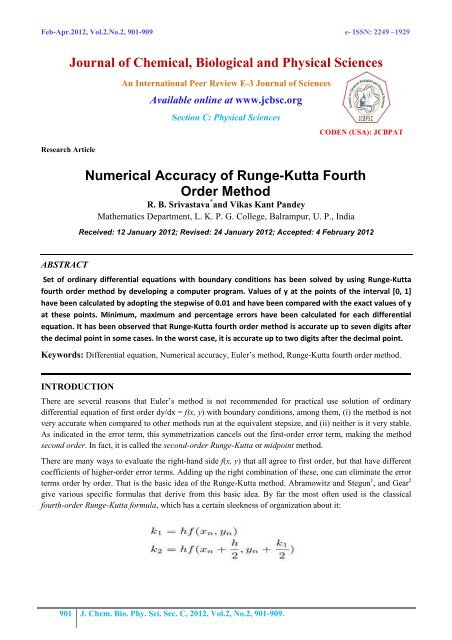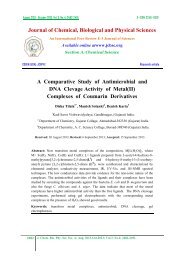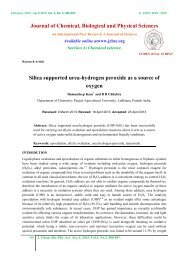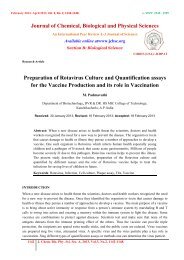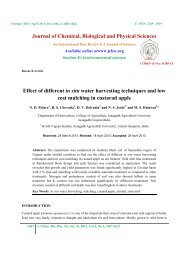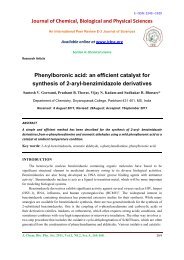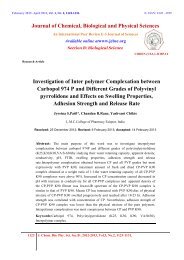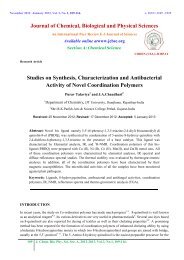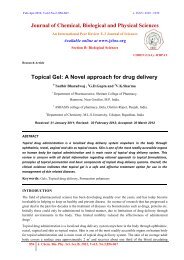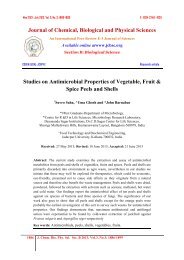Numerical Accuracy of Runge-Kutta Fourth Order Method
Numerical Accuracy of Runge-Kutta Fourth Order Method
Numerical Accuracy of Runge-Kutta Fourth Order Method
- No tags were found...
You also want an ePaper? Increase the reach of your titles
YUMPU automatically turns print PDFs into web optimized ePapers that Google loves.
Feb-Apr.2012, Vol.2.No.2, 901-909 e- ISSN: 2249 –1929Research ArticleJournal <strong>of</strong> Chemical, Biological and Physical SciencesAn International Peer Review E-3 Journal <strong>of</strong> SciencesAvailable online at www.jcbsc.orgSection C: Physical SciencesCODEN (USA): JCBPAT<strong>Numerical</strong> <strong>Accuracy</strong> <strong>of</strong> <strong>Runge</strong>-<strong>Kutta</strong> <strong>Fourth</strong><strong>Order</strong> <strong>Method</strong>R. B. Srivastava * and Vikas Kant PandeyMathematics Department, L. K. P. G. College, Balrampur, U. P., IndiaReceived: 12 January 2012; Revised: 24 January 2012; Accepted: 4 February 2012ABSTRACTSet <strong>of</strong> ordinary differential equations with boundary conditions has been solved by using <strong>Runge</strong>-<strong>Kutta</strong>fourth order method by developing a computer program. Values <strong>of</strong> y at the points <strong>of</strong> the interval [0, 1]have been calculated by adopting the stepwise <strong>of</strong> 0.01 and have been compared with the exact values <strong>of</strong> yat these points. Minimum, maximum and percentage errors have been calculated for each differentialequation. It has been observed that <strong>Runge</strong>-<strong>Kutta</strong> fourth order method is accurate up to seven digits afterthe decimal point in some cases. In the worst case, it is accurate up to two digits after the decimal point.Keywords: Differential equation, <strong>Numerical</strong> accuracy, Euler’s method, <strong>Runge</strong>-<strong>Kutta</strong> fourth order method.INTRODUCTIONThere are several reasons that Euler’s method is not recommended for practical use solution <strong>of</strong> ordinarydifferential equation <strong>of</strong> first order dy/dx = f(x, y) with boundary conditions, among them, (i) the method is notvery accurate when compared to other methods run at the equivalent stepsize, and (ii) neither is it very stable.As indicated in the error term, this symmetrization cancels out the first-order error term, making the methodsecond order. In fact, it is called the second-order <strong>Runge</strong>-<strong>Kutta</strong> or midpoint method.There are many ways to evaluate the right-hand side f(x, y) that all agree to first order, but that have differentcoefficients <strong>of</strong> higher-order error terms. Adding up the right combination <strong>of</strong> these, one can eliminate the errorterms order by order. That is the basic idea <strong>of</strong> the <strong>Runge</strong>-<strong>Kutta</strong> method. Abramowitz and Stegun 1 , and Gear 2give various specific formulas that derive from this basic idea. By far the most <strong>of</strong>ten used is the classicalfourth-order <strong>Runge</strong>-<strong>Kutta</strong> formula, which has a certain sleekness <strong>of</strong> organization about it:901 J. Chem. Bio. Phy. Sci. Sec. C, 2012, Vol.2, No.2, 901-909.
<strong>Numerical</strong> <strong>Accuracy</strong>.....R. B. Srivastava and V. K. Pandey.The RK4 method is a fourth-order method, meaning that the error per step is on the order <strong>of</strong>h 5 , while the total accumulated error has order h 4 .We have solved the differential equations given in Table-1 at the points0=x 0 , x 1 , x 2 … x n =1, n=100, x i – x i-1 = 0.01, i=1, 2, …., 100With the help <strong>of</strong> <strong>Runge</strong>-<strong>Kutta</strong> fourth order method by using the following computer program developed by us.#include#include#include//<strong>Runge</strong>-<strong>Kutta</strong> 4void main(void){FILE *fpt;int i;float a,b,x0,y0,h,h1,k1,k2,k3,k4,k5;double ev, y1;double f(float x, float y);clrscr();fpt=fopen("vikas5.txt", "w");printf("Boundary conditions\n");printf("x0= ");scanf("%f", &x0);printf("y0= ");scanf("%f", &y0);a=0; b=1;h=(b-a)/100;fprintf(fpt,"a= %6.2f\n",a);fprintf(fpt,"b= %5.2f\n",b);fprintf(fpt,"h= %7.2f\n",h);//to write DEfprintf(fpt,"f(x,y)=(4x^2-2xy)/(1+x^2), x=0, y=0\n");fprintf(fpt,"Value <strong>of</strong> x Exact value Value by RK4\n");for(i=1; i
<strong>Numerical</strong> <strong>Accuracy</strong>.....R. B. Srivastava and V. K. Pandey.k2=h1*f(x0+h1/4,y0+k1/4);k3=h1*f(x0+3*h1/8,y0+3*k1/32+9*k2/32);k4=h1*f(x0+12*h1/13,y0+1932*k1/2197-7200*k2/2197+7296*k3/2197);k5=h1*f(x0+h1,y0+439*k1/216-8*k2+3680*k3/513-845*k4/4104);y1=y0+25*k1/216+1408*k3/2565+2197*k4/4104-k5/5;//exact value write h1 for xev=(4*h1*h1*h1)/(3*(1+h1*h1));fprintf(fpt,"%7.2f %22.14f %22.14f %22.14f\n",h1,ev,y1);}fclose(fpt);}double f(float x, float y){double r;r=(4*x*x-2*x*y)/(1+x*x);return(r);}With the help <strong>of</strong> above computer program, we have calculated the value <strong>of</strong> y, exact value <strong>of</strong> y,difference between calculated and exact values <strong>of</strong> y and percentage error in the value <strong>of</strong> y. We havecalculated the values <strong>of</strong> y in the interval [0, 1] by assuming the step size <strong>of</strong> 0.01. Percentage error in the value<strong>of</strong> y is defined asPE y=Difference in the calculated and exact values <strong>of</strong> yExact value <strong>of</strong> yx 100Table-1: Differential equations with boundary conditions along with exact solutionsS. No. Differential Equation Boundary Condition Exact Solution1 dy/dx = y - x y=2 when x=0 y=e x +x+12 dy/dx = 1 + x y=1 when x=0 y=x 2 /2+x+13 dy/dx = x + y + 1 y=1 when x=0 y=3e x -x-24 dy/dx = -x + y + 1 y=1 when x=0 y=e x +x5 dy/dx = x / y y=1 when x=0 y=(x 2 +1) 1/26 dy/dx = x + y y=1 when x=0 y=2e x -x-17 dy/dx = -(1 +x) y 2 / 2 y=1 when x=0 y=4/(x 2 +2x+4)8 dy/dx = 1 + y 2 y=0 when x=0 y=tan x9 dy/dx = -xy 2 y=1 when x=0 y=2/(x 2 +2)10 dy/dx = x 2 - y y=1 when x=0 y=-e -x +x 2 -2x+211 dy/dx = 3x + y / 2 y=1 when x=0 y=13e x/2 -6x-1212 dy/dx = 1 - y y=0 when x=0 y=1-e -x13 dy/dx = 1 + y y=0 when x=0 y=e x -114 dy/dx = 1 / (2y) y=1 when x=0 y=(x+1) 1/215 dy/dx = (4x 2 – 2xy) / (1 + x 2 ) y=0 when x=0 y=4x 3 /{3(x 2 +1)}904 J. Chem. Bio. Phy. Sci. Sec. C, 2012, Vol.2, No.2, 901-909.
<strong>Numerical</strong> <strong>Accuracy</strong>.....R. B. Srivastava and V. K. Pandey.RESULT AND DISCUSSION<strong>Accuracy</strong> <strong>of</strong> Solution <strong>of</strong> Differential equation dy/dx = y – x, y=2 when x=0, by <strong>Runge</strong>-<strong>Kutta</strong> fourth ordermethod.Differential equation has been solved by <strong>Runge</strong>-<strong>Kutta</strong> fourth order method with the help <strong>of</strong> computer programat different points <strong>of</strong> x. Exact values <strong>of</strong> y at these points have also been calculated. Exact value <strong>of</strong> y,calculated value <strong>of</strong> y by <strong>Runge</strong>-<strong>Kutta</strong> fourth order method and difference between them at different points isincluded in Table-2. A close look to this Table indicates the followingMaximum Error = 0.00033308425264Minimum Error = 0.00000000012960Maximum Percentage Error = 0.00705943953222Minimum Percentage Error = 0.00000000635231It is clear that the accuracy <strong>of</strong> <strong>Runge</strong>-<strong>Kutta</strong> fourth order method is up to 3 places after the decimalpoint. Graph between errors in the value <strong>of</strong> y calculated by <strong>Runge</strong>-<strong>Kutta</strong> fourth order method at differentpoints is shown in Graph-1.Table-2: Exact value <strong>of</strong> y, calculated value <strong>of</strong> y by <strong>Runge</strong>-<strong>Kutta</strong> fourth order method and difference betweenthem at different points for differential equation dy/dx = y – x, y=2 when x=0Value<strong>of</strong> xExact value <strong>of</strong> y fordy/dx = y – x, y=2when x=0Value <strong>of</strong> y calculatedby <strong>Runge</strong>-<strong>Kutta</strong>fourth order method905 J. Chem. Bio. Phy. Sci. Sec. C, 2012, Vol.2, No.2, 901-909.Difference betweenexact value <strong>of</strong> y andvalue calculated by<strong>Runge</strong>-<strong>Kutta</strong> fourthorder method0.01 2.02005016663488 2.02005016685982 0.000000000224940.02 2.04020133912365 2.04020133925325 0.000000000129600.03 2.06045453259199 2.06045452780589 0.000000004786100.04 2.08081077236776 2.08081077342820 0.000000001060440.05 2.10127109026275 2.10127108927387 0.000000000988880.06 2.12183654378022 2.12183654261734 0.000000001162880.07 2.14250818187187 2.14250818201164 0.000000000139770.08 2.16328706394975 2.16328707694876 0.000000012999010.09 2.18417427559174 2.18417428742883 0.000000011837090.10 2.20517090552785 2.20517092544157 0.000000019913720.11 2.22627806919747 2.22627810534910 0.000000036151630.12 2.24749684587298 2.24749688033747 0.000000034464490.13 2.26882837312589 2.26882842200250 0.000000048876610.14 2.29027380013889 2.29027386482289 0.000000064684000.15 2.31183422339997 2.31183428739943 0.000000063999460.16 2.33351086321872 2.33351097284411 0.000000109625390.17 2.35530485522799 2.35530500954877 0.000000154320780.18 2.37721734609644 2.37721754868476 0.000000202588320.19 2.39924959238999 2.39924984033896 0.000000247948970.20 2.42140273167898 2.42140306028706 0.000000328608080.21 2.44367804531160 2.44367841415499 0.00000036884339
<strong>Numerical</strong> <strong>Accuracy</strong>.....R. B. Srivastava and V. K. Pandey.Value<strong>of</strong> xExact value <strong>of</strong> y fordy/dx = y – x, y=2when x=0Value <strong>of</strong> y calculatedby <strong>Runge</strong>-<strong>Kutta</strong>fourth order method906 J. Chem. Bio. Phy. Sci. Sec. C, 2012, Vol.2, No.2, 901-909.Difference betweenexact value <strong>of</strong> y andvalue calculated by<strong>Runge</strong>-<strong>Kutta</strong> fourthorder method0.22 2.46607672790984 2.46607722292634 0.000000495016500.23 2.48859998569732 2.48860059120559 0.000000605508270.24 2.51124913813747 2.51124987421706 0.000000736079590.25 2.53402541668774 2.53402632862387 0.000000911936130.26 2.55693006476053 2.55693115368921 0.000001088928680.27 2.57996440667417 2.57996571955450 0.000001312880330.28 2.60312981510682 2.60313133016141 0.000001515054590.29 2.62642746852880 2.62642924608136 0.000001777552560.30 2.64985876555725 2.64986079205372 0.000002026496470.31 2.67342511976702 2.67342752353315 0.000002403766130.32 2.69712774733341 2.69713052952731 0.000002782193900.33 2.72096808856019 2.72097123238252 0.000003143822330.34 2.74494759916435 2.74495113494335 0.000003535779000.35 2.76906753417449 2.76907159062156 0.000004056447070.36 2.79332937685052 2.79333396808736 0.000004591236840.37 2.81773462633503 2.81773974954733 0.000005123212300.38 2.84228457769313 2.84229031245262 0.000005734759490.39 2.86698075844914 2.86698710639283 0.000006347943690.40 2.89182463823154 2.89183175251555 0.000007114284010.41 2.91681777614777 2.91682561894199 0.000007842794220.42 2.94196152254809 2.94197016297086 0.000008640422770.43 2.96725746607999 2.96726698379012 0.000009517710130.44 2.99270721242520 2.99271755142983 0.000010339004630.45 3.01831215487350 3.01832349572265 0.000011340849150.46 3.04407392954626 3.04408627173356 0.000012342187300.47 3.06999419011792 3.07000753394751 0.000013343829590.48 3.09607437412546 3.09608880885918 0.000014434733720.49 3.12231616660996 3.12233175866262 0.000015592052660.50 3.14872127070012 3.14873794946986 0.000016678769740.51 3.17529116952768 3.17530912494915 0.000017955421470.52 3.20202759854326 3.20204668269868 0.000019084155420.53 3.22893223140147 3.22895247717233 0.000020245770860.54 3.25600675857742 3.25602835440031 0.000021595822890.55 3.28325305045031 3.28327580887323 0.000022758422920.56 3.31067250685421 3.31069659501837 0.000024088164160.57 3.33826703163354 3.33829234570671 0.000025314073170.58 3.36603838425304 3.36606500001213 0.000026615759090.59 3.39398834186033 3.39401597622890 0.000027634368570.60 3.42211869946367 3.42214760475339 0.000028905289720.61 3.45043143941433 3.45046140015357 0.000029960739240.62 3.47892805547877 3.47895915055135 0.000031095072580.63 3.50761056554282 3.50764246426130 0.000031898718480.64 3.53648083787046 3.53651363241974 0.00003279454928
<strong>Numerical</strong> <strong>Accuracy</strong>.....R. B. Srivastava and V. K. Pandey.Value<strong>of</strong> xExact value <strong>of</strong> y fordy/dx = y – x, y=2when x=0Value <strong>of</strong> y calculatedby <strong>Runge</strong>-<strong>Kutta</strong>fourth order methodDifference betweenexact value <strong>of</strong> y andvalue calculated by<strong>Runge</strong>-<strong>Kutta</strong> fourthorder method0.65 3.56554075950198 3.56557414646734 0.000033386965360.66 3.59479223644277 3.59482620826125 0.000033971818480.67 3.62423719385382 3.62427160610348 0.000034412249660.68 3.65387775350127 3.65391222490088 0.000034471399610.69 3.68371552610550 3.68375003527828 0.000034509172780.70 3.71375267154374 3.71378684756700 0.000034176023260.71 3.74399119354436 3.74402481613219 0.000033622587830.72 3.77443311597351 3.77446579898890 0.000032683015390.73 3.80508048303754 3.80511193741948 0.000031454381940.74 3.83593554401950 3.83596542160413 0.000029877584630.75 3.86700001661267 3.86702789680534 0.000027880192670.76 3.89827619056788 3.89830162331142 0.000025432743540.77 3.92976619351715 3.92978849283203 0.000022299314880.78 3.96147217447555 3.96149109122116 0.000018916745610.79 3.99339630405606 3.99341102589873 0.000014721842670.80 4.02554077468669 4.02555064856425 0.000009873877560.81 4.05790799442008 4.05791232240246 0.000004327982380.82 4.09049981413996 4.09049789739979 0.000001916740170.83 4.12331868530099 4.12330945347368 0.000009231827310.84 4.15636688980590 4.15634970411106 0.000017185694840.85 4.18964673249091 4.18962077102814 0.000025961462770.86 4.22316054135619 4.22312433082341 0.000036210532780.87 4.25691086967432 4.25686382100596 0.000047048668360.88 4.29089969015277 4.29084057921786 0.000059110934910.89 4.32512960214995 4.32505687468233 0.000072727467620.90 4.35960302867358 4.35951543682732 0.000087591846260.91 4.39432241708300 4.39421840421637 0.000104012866630.92 4.42929023933389 4.42916812659704 0.000122112736850.93 4.46450920289863 4.46436762826600 0.000141574632630.94 4.49998140984161 4.49981847737151 0.000162932470100.95 4.53570961657085 4.53552385239224 0.000185764178610.96 4.57169639592452 4.57148554123516 0.000210854689360.97 4.60794434659819 4.60770638089547 0.000237965702720.98 4.64445609340476 4.64418876232111 0.000267331083650.99 4.68123428753690 4.68093534070729 0.000298946829611.00 4.71828182845904 4.71794874420640 0.00033308425264907 J. Chem. Bio. Phy. Sci. Sec. C, 2012, Vol.2, No.2, 901-909.
<strong>Numerical</strong> <strong>Accuracy</strong>.....R. B. Srivastava and V. K. Pandey.DifferentialEquationMaximum Error in the value <strong>of</strong>y calculated by <strong>Runge</strong>-<strong>Kutta</strong>fourth order methodMaximum Percentage Error inthe value <strong>of</strong> y calculated by<strong>Runge</strong>-<strong>Kutta</strong> fourth ordermethodDE13 0.00033321188559 0.01939215558654DE14 0.00002414770471 0.00170750057505DE15 0.00245770275244 0.36865541286600Average 0.00116602888541 0.13989860729377REFERENCES1. M.Abramowitz and I.A.Stegun, 1964, Handbook <strong>of</strong> Mathematical Functions, Applied Mathematics.2. Series, Volume 55 (Washington: National Bureau <strong>of</strong> Standards; reprinted 1968 by Dover Publications,New York), Gear, C.W. 1971, <strong>Numerical</strong> Initial Value Problems in Ordinary Differential Equations(Englewood Cliffs, NJ: Prentice-Hall), Chapter 2.3. L.F.Shampine and H.A.Watts, 1977, in Mathematical S<strong>of</strong>tware III, J.R. Rice, ed. (New York: AcademicPress), pp. 257–275; 1979, Applied Mathematics and Computation, vol. 5, pp. 93–121.4. J.R.Rice, 1983, <strong>Numerical</strong> <strong>Method</strong>s, S<strong>of</strong>tware, and Analysis (New York: McGraw-Hill).5. J. Stoer and R. Bulirsch, 1980, Introduction to <strong>Numerical</strong> Analysis (New York: Springer-Verlag)6. S.Blanes,F.; Casas, J. Ros, Special issue: Themes in geometric integration. Appl. Numer. Math.,2001, 39,3-4, 245.7. K.Murugesan, Dhayabaran, D. Paul E.C. Amirtharaj, Henry Evans, J. David ,Int. J. Comput. Math., 2002, 79, 2, 247.8. G.Papageorgiou, I Famelis, Comput. Math. Appl.,2001, 42, 8-9, 1165.9. Ling Xiang, Tu, Shan-Tung; Gong, Jian-Ming; International Journal <strong>of</strong> Pressure Vessels and Piping,2000, 77, 5, 243.10. Chou, Lin-Yi; Sharp, P. W.; J. Appl. Math. Decis. Sci., 2000, 4, 2, 143.11. Tsitouras, Ch.; Celestial Mech. Dynam. Astronom., 1999,74, 4, 223.12. Burnton, Christopher; Scherer, Rudolf; BIT, 1998, 38, 1, 12.13. Peter Albrecht; SIAM Journal on <strong>Numerical</strong> Analysis, 1996, 33, 5, 1712.14. Dumitras, Daria Elena; Automat. Comput. Appl. Math., 1997, 6, 2, 42.15. J.H.Verner, Applied <strong>Numerical</strong> Mathematics,1996, 22, 1-3, 345.16. P.Bogacki, L.F. Shampine, Source; Computers & Mathematics with Applications,1996, 32, 6, 15.17. C.Fredebeul, D. Kornmaier, M.W. Muller, Journal <strong>of</strong> Computational and Applied Mathematics, 2002,144,1-2, 187.18. A.B.Sideridis, T.E. Simos, J. Comput. Appl. Math.,1992 44, 2, 235.19. Daniel Okunbor, D. Robert Skeel; SIAM Journal on <strong>Numerical</strong> Analysis, 1992, 29, 2, 521.20. Dumitras, Daria Elena; Automat. Comput. Appl. Math., 1993, 2, 2, 139.21. J.H.Verner, SIAM J. Numer. Anal., 1991, 28, 2, 496.22. J.H.Verner, SIAM Journal on <strong>Numerical</strong> Analysis, 1990, 27, 5, 1332.23. P.J.Van der Houwen,B.P. Sommeijer, SIAM Journal on <strong>Numerical</strong> Analysis,1989, 26, 2, 414.909 J. Chem. Bio. Phy. Sci. Sec. C, 2012, Vol.2, No.2, 901-909.


